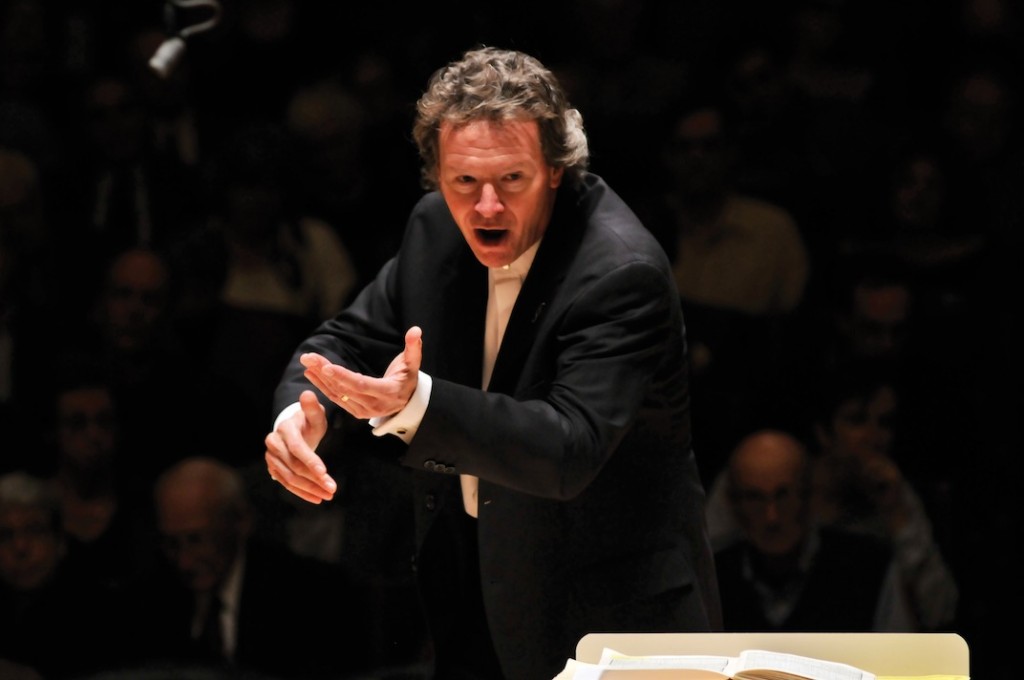Handel and Haydn Society opens with a varied and seasonally bracing program

Harry Christophers conducted the Handel and Haydn Society in their season-opening concert Friday night at Symphony Hall.
Welcoming applause and an air of anticipation greeted the Handel and Haydn Society musicians and artistic director Harry Christophers as they took the stage at Symphony Hall Friday night.
The Society launched its new season with “Mozart in Vienna,” a program pitting shorter pieces by elder contemporaries Haydn and Dittersdorf alongside extended works from the young genius’s sojourn in the “city of music.”
The overture to “Autumn” from The Seasons set the bucolic mood, the orchestra unveiling rich, organic colors over Haydn’s charming country waltz.
Haydn’s expansive orchestral palette was immediately contrasted with the spare scoring of his Concertino in F Major. Soloist Kristian Bezuidenhout’s spry phrasing made this galant, lighthearted work emerge with vigor and spontaneity. Bezuidenhout’s rhythmic lilt nicely spiced the second movement’s wispy phrases, and the roulades of the lightning third movement were crisply articulated albeit with some fitfully pallid expression from the soloist. Some faster passages occasionally sounded muddled on the soloist’s 1835 fortepiano, copied from models by Bösendorfer and Graf, yet the instrument’s tone projected clearly in Symphony Hall’s resonant acoustic.
Haydn’s “Winter” overture from The Seasons upped the emotional ante with sprawling textures evoking frozen landscapes, the Society woodwinds bubbling up through the strings’ glistening surface. Christophers once again paced the narrative beautifully, accentuating key phrases without overindulgence, and stoking real power from ensemble sections.
Those tutti effects segued perfectly into the propulsion and grandeur of Mozart’s Piano Concerto No. 22. Following an introduction dominated by basses and timpani, Christophers and the orchestra quickly readjusted the balance for more lucid results. At first Bezuidenhout’s solo playing seemed a bit reserved, yet the fortepianist was clearly building from ensemble member to solo protagonist during the development, leaning into his phrases and playfully parrying with bassoon and flute. In the elegiac second movement, Bezuidenhout’s solo playing was tastefully reflective, if occasionally undone by overemphatic clarinets and bassoons, though the winds’ ensuing dialog was more fluently handled.
Kicked off in lively fashion by horns and timpani, Mozart’s finale raced along in irresistible rhythm, capped off by Bezuidenhout’s immaculate fingerwork and attentive detailing. The soloist’s jazzy ornaments during the cantabile section sparked a chamber intimacy alongside the obbligato violin solos. Bezuidenhout enlivened his cadenza with harmonically arresting touches, highlighting Mozart’s most endearing turns of phrase before ending on a whisper. This humorous effect was Christophers’ cue to gradually and gracefully rev up the orchestra’s engines for an emphatic coda.
Carl Ditters von Dittersdorf’s comparatively straightforward overture to his oratorio Esther followed after intermission. Christophers led a performance that was driven and clear-textured, the strings taking on a somewhat steely tone during the middle section.
Mozart’s Symphony No. 40 in G Minor closed the evening, serving double duty as an example of the composer’s full artistic maturity as well as deftly spotlighting the full Handel and Haydn Society orchestra’s rich palette, dynamic agility and transparency of sound.
The first movement’s tense opening motif was enhanced by an ideal balance with the restless violas underneath, Christophers’ thundering climaxes adding biting drama. Despite somewhat gruff horn playing, the strings in the lyrical second movement shimmered and expanded fluently under Christophers’ direction, allowing Mozart’s textures to breathe and dissonances to make their full impact. Stormy bass lines added potency to the third movement Menuetto, and the performance of the final movement emphasized the frantic, mordant aspects of the score.
If historically informed performance aims to present music as freshly to today’s audiences as it existed in the composer’s mind, the Handel and Haydn Society surely explored the raw potential of these works as well as their lyric elegance.
The program will be repeated 3 p.m. Sunday at Symphony Hall. handelandhaydn.org; 617-266-3605
Andrew J. Sammut studied philosophy as an undergraduate at Boston University and music during every free moment throughout his life. He also writes for The Boston Musical Intelligencer, Early Music America, All About Jazz and on his blog at clefpalette.wordpress.com. Originally from Brooklyn, he now lives in Cambridge.
Posted in Performances